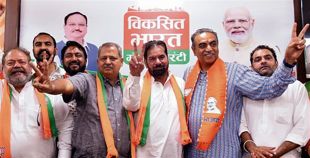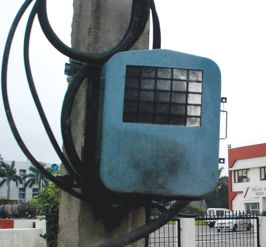
Reality check: This is a compressionary Budget, which will leave little additional money after adjusting for inflation. PTI
Senior Economic Analyst
IN order to understand what has gone into the making of this Budget, it is necessary to put it in context. It is an interim Budget, not the full one, which will be unveiled by the new government that will come to power later this year. Such exercises are also called ‘vote on account’ budgets that just sanction enough funds to various departments to keep the government running till the full Budget is presented.
What makes things a bit complex is that it is also a pre-election Budget that will seek to boost the feel-good factor for the ruling dispensation. All interim budgets, except the 2019 one — the first one presented by the current dispensation — contained no new taxation proposals. Thus, the ground had been laid for another out-of-the-ordinary ‘vote on account’ Budget that would seek to do the needful, maybe through a dramatic announcement of freebies, with or without going in for a fresh taxation effort.
It is also important to note that the economy is in a very good shape, projected by the government to grow this year and the next by over 7 per cent. The IMF projection is a little lower at 6.5 per cent. With a high level of foreign exchange reserves of over $600 billion and the rupee’s exchange value very stable, the government can take the credit and reap the benefits of sound economic management at a time when the world economy has been wracked by the wars in Ukraine and Palestine and hindrance to global trade through the disruption of Red Sea cargo traffic.
It is not as if there is no downside to this positive picture. Private personal consumption expenditure has not been doing well, according to statistics collected by independent data agencies. This has been reflected in the near-stagnant growth in sales volumes of FMCG (fast-moving consumer goods) companies and also in the number of people looking for jobs and finding one. The figure is particularly poor for women. According to Mahesh Vyas, chief of the Centre for Monitoring Indian Economy, only 40 per cent of the population aged 15 years or above has jobs; the rest are dependents. So, robust economic growth is leaving behind those at the bottom of the pyramid and going into the hands of the better-off who are spending it on things like SUVs and higher-end motorbikes. A Budget that seeks to lay the foundations for an assured electoral victory should have plenty of goodies for the common man, never mind creating a temporary setback to the ongoing process of fiscal stabilisation.
Now let us look at what has been put on the table. The Budget speech was an out and out a pre-election campaign exercise, an undated election manifesto full of claims of what had been achieved in the last 10 years and a promise of more positive developments. Among the latter, it is worth noting the mention of the goals of producing more solar power, higher oilseeds output and increasing the number of medical colleges.
A key number that needs highlighting is the fiscal deficit, which in the Budget estimate for 2023-24 was projected at 5.9 per cent of the GDP and has been revised to 5.8 per cent. In the Budget estimate for the upcoming financial year, it is pegged at 5.1 per cent of the GDP. Thus, while the government has managed to remain on course during the current fiscal, it has set itself a tall target of a substantial reduction. This deficit as a percentage of government revenue went up during the Covid pandemic but has thereafter been coming down. But still, a 70 basis-point reduction is a tall order. The Confederation of Indian Industry had indicated before the Budget that a target of 5.4 per cent could be attempted, but the government has gone much beyond that. Thus, nobody can accuse the government of being overly ambitious in pursuing the goal of fiscal consolidation.
As this is an interim Budget, no fresh taxes have been introduced, and the direct and indirect tax structures remain unaltered. Within this, two small measures have been taken that will deliver little bits of relief. Certain tax benefits to startups and investment by sovereign wealth and pension funds were to expire by this March. These have been extended till next March. Further, old outstanding tax demands up to Rs 25,000 till 2009-10 and up to
Rs 10,000 for the period from 2010-11 to 2014-15 will be withdrawn.
But there is a hidden reality behind the Budget speech in the detailed numbers. This is a compressionary Budget, which will leave little real additional money after adjusting for inflation for expenditure. This is to meet the increase in interest outgo on account of a rapidly growing public debt in recent years. Over the next two years, all departmental expenditure is set to shrink in real terms except on health and education.
During the first five years of Modi rule, the government was able to reap the benefit of falling international oil prices from the peak they reached by the end of the Manmohan Singh period by mopping up the surplus through changes in excise duty. The next five years of Modi’s reign had no such luck. As a result, the fiscal deficit went up sharply, particularly to meet the expenditure needs arising out of the Covid-induced disruptions.
If this is the way government finances are likely to pan out, where will the funds come from to meet the promises made in the Budget speech? Although this appears on the face of it to be an innocuous interim Budget, it contains signals of hard times to come for the managers of the government’s finances.
The document released in lieu of the Economic Survey clearly states that in the years to come, private sector capital expenditure will have to fill the gap left behind as the government will not be able to maintain the capex momentum that it had till now achieved. This ties up with the compressionary picture that the detailed numbers create. How the government will deliver on the promise of continuing good times, essential for winning elections, remains to be seen.
Join Whatsapp Channel of The Tribune for latest updates.




























